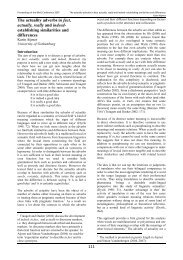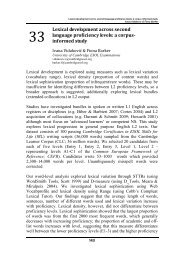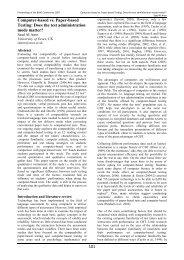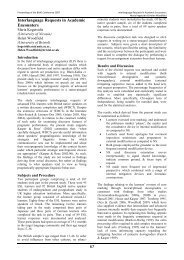Proceedings of the - British Association for Applied Linguistics
Proceedings of the - British Association for Applied Linguistics
Proceedings of the - British Association for Applied Linguistics
Create successful ePaper yourself
Turn your PDF publications into a flip-book with our unique Google optimized e-Paper software.
The Impact <strong>of</strong> <strong>Applied</strong> <strong>Linguistics</strong>: <strong>Proceedings</strong> <strong>of</strong> <strong>the</strong> 44th Annual Meeting <strong>of</strong> BAAL<br />
University <strong>of</strong> <strong>the</strong> West <strong>of</strong> England<br />
Results<br />
The questionnaire results indicate that <strong>the</strong> perceived importance <strong>of</strong> <strong>the</strong><br />
learners’ exposure to a standard <strong>British</strong> or American accent was greater<br />
compared to <strong>the</strong> learners’ exposure to standard regional, non-standard<br />
regional, or non-native accents <strong>of</strong> English (see Table 16.1). A similar<br />
pattern emerged in <strong>the</strong> teachers’ responses in terms <strong>of</strong> <strong>the</strong> frequency <strong>of</strong><br />
learners’ exposure to various accents <strong>of</strong> English through <strong>the</strong> listening<br />
material <strong>of</strong> <strong>the</strong> course (see Table 16.2). Even though nowadays English is<br />
primarily used <strong>for</strong> communication among non-native speakers <strong>of</strong> English<br />
(see Jenkins, 2000), non-native accents <strong>of</strong> English received <strong>the</strong> lowest<br />
rating <strong>of</strong> all questionnaire items (see Table 16.2).<br />
Native speakers <strong>of</strong> a standard <strong>British</strong> variety, i.e.<br />
Received Pronunciation<br />
Native speakers <strong>of</strong> a standard American variety,<br />
i.e. General American<br />
Native speakers <strong>of</strong> standard regional varieties <strong>of</strong><br />
English, e.g. Scottish, Nor<strong>the</strong>rn<br />
Native speakers <strong>of</strong> non-standard regional<br />
varieties <strong>of</strong> English e.g. Cockney<br />
Non- native (e.g. Italian, Bulgarian) but fluent<br />
speakers <strong>of</strong> English<br />
84<br />
N Mean Std Dev<br />
47 1.62 0.945<br />
46 1.67 1.055<br />
46 2.61 0.977<br />
46 3.17 1.141<br />
46 3.11 1.197<br />
Table 16.1: Perceived importance <strong>of</strong> exposure to a variety <strong>of</strong> accents <strong>of</strong> English<br />
through <strong>the</strong> listening material <strong>of</strong> <strong>the</strong> course (1 = extremely important; 5 = not at all<br />
important)<br />
N Mean Std Dev<br />
Native speakers <strong>of</strong> a standard <strong>British</strong> variety 47 1.74 0.871<br />
Native speakers <strong>of</strong> a standard American variety<br />
Native speakers <strong>of</strong> standard regional varieties <strong>of</strong><br />
English<br />
Native speakers <strong>of</strong> non-standard regional<br />
varieties <strong>of</strong> English<br />
47<br />
44<br />
44<br />
2.02<br />
2.91<br />
3.70<br />
0.989<br />
1.178<br />
1.091<br />
Non-native but fluent speakers <strong>of</strong> English 46 3.78 1.172<br />
Table 16.2: Frequency <strong>of</strong> exposure to a variety <strong>of</strong> accents <strong>of</strong> English through <strong>the</strong><br />
listening material <strong>of</strong> <strong>the</strong> course (1 = always; 5 = never)







